![]()
![]()
![]()
Use LEFT and RIGHT arrow keys to navigate between flashcards;
Use UP and DOWN arrow keys to flip the card;
H to show hint;
A reads text to speech;
76 Cards in this Set
- Front
- Back
|
What percentage of all deaf children and hard-of-hearing children have Usher syndrome
|
3-6 % |
|
|
What is the Impact of Congenital Hearing Loss |
- Influence Speech and Language acquisition - Psychological and social development - Academic Achievement - Social integration. - Significant economic cost - Other problems-family etc., |
|
|
What is the economic loss related to hearing loss? |
Higher rates of unemployment and underemployment Life time wages are less than their comparably educated normally hearing counterparts. Unaided income differential - $20,300 • Aided income differential - $10,200 |
|
|
What is the history of audiology? |
World War II soldiers were being deafened by explosions so the army recruited some speech specialists (Raymond Carhart) a SLP and an Otologist Norton Canfield, who together developed aural rehabilitation programs. |
|
|
What is audiology? |
Audiology: is the branch of science that studies hearing, balance, and related disorders. (from Latin root audīre, "to hear"; and from Greek –logos “the study of”)
|
|
|
What is an audiologist? |
Person concerned with the identification, assessment, diagnosis, and treatment of persons with impairments of auditory and vestibular function and the prevention of impairments associated with them. (AAA 2004) |
|
|
Audiologist Are Experts In…. |
-The diagnosis of hearing disorders -Non-medical management of the auditory system.
-Experts in prevention of hearing loss. -In assessment and rehabilitation of persons with balance disorders |
|
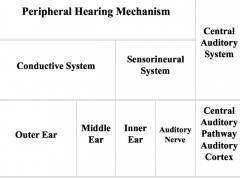
|
What are the systems on either side of the brainstem? |
|

Explain this picture. |
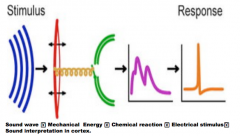
|
|
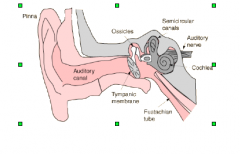
|
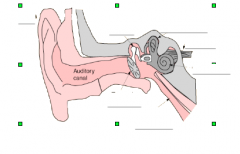
. |
|
|
When are the outer ear, external auditory canal and tympanic membrane completed developing? |
Development of the outer ear, external auditory canal and tympanic membrane is not completed until puberty |
|
|
How does the middle ear begin to develop as an embryo and continue? |
Development begins around the 4th gestational week Ossicles formed by the 16th week - remain the same size Middle ear complete by about the 30th week, Some ossification of the stapes continues until puberty |
|
|
What occurs at birth in the outer and middle ear? |
Complete pneumatization - draining of the canals on either side of the ear drum |
|
|
What are the 3 Major Components of the Outer Ear? |
Pinna (auricle) Ear canal Tympanic Membrane |
|
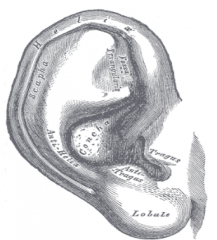
What are the 4 major components of the Auricle/Pinna?
|
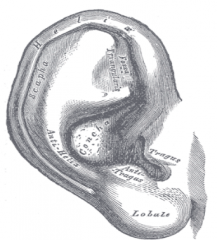
Helix Antihelix Lobule Conch Tragus Antitragus |
|
|
What is the purpose of the Pinna? |
Amplifies sound, protects, visual shows that everything is normal |
|
|
How long is the External Auditory Canal? |
About 27 mm long 1.06 inches |
|
|
What is included in the outer 2/3 of the external auditory canal and what is it made of? |
Cartilaginous Contains sebaceous and ceruminous glands Hair follicles |
|
|
What is included in the inner 1/3 of the external auditory canal and what is it made of? |
Boney (temporal bone) Terminates with the Tympanic membrane (TM) |
|
|
What are the 3 layers of the Tympanic Membrane? |
Canal Layer (epidermal) - contiguous with the outer ear Middle Layer fibrous tissue - gives body and texture to keep it taut Inner layer mucoid |
|
|
List the 5 parts of the TM |
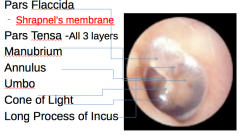
Annulus - long process of the malius |
|
|
What is pars flaccida or Shrapnell's membrane? The small, triangular, flaccid portion of the tympanic membrane |
The small, triangular, flaccid portion of the tympanic membrane. It responds to pressure changes and blows out instead of the eardrum. |
|
|
What are the Outer Ear-Two Functions
|
Auditory & Non-auditory |
|
|
What are the auditory functions of the outer ear? |
Funneling - Catches and funnels sound, compresses sound signals above 5K Hz Transfer function - TIme difference - For location 2millisecond difference helpt to locate where sound is coming Level difference - sounds louder to the ear that is closer
|
|
|
What provides cues for the time and level differences? |
Level difference - higher frequencies above 2000hz Time difference - low frequencies |
|
|
What are the non-auditory functions of the outer ear? |
S Shape protects - against q-tip, pins, sticks Sebaceous Glands Produce Cerumen Noxious (keeps bugs out), Lubricates Maintains Ph (avoids ear infections) Traps debris, (Aids in removal of debris) Hair cells aid cerumen |
|
|
What are deceases of the outer ear? |
Atresia - Lack of External Ear Canal ** Microtia - Small ear ** Anotia - No ear ** May have External Auditory Canal (EAC) behind epithelium or canal may also be missing. (Often have normal cochlea)
|
|
|
What is a Preauricular tag/sinus and how can it be effect? |
May indicate incomplete closure of hillocks or interference of hillock development
Inflamed Preauricular Sinus |
|
|
What are outer ear conditions? |
Preauricular tag/sinus Auricular Hematoma/Cauliflower Ear Basal Cell Carcinoma Collapsed Canal/Canal Occluded Ear Canal Exostoses/Osteomas |
|
|
What are Exostoses/Osteomas |
Growths within the ear canal probably from swimming in order to protect the canal Exostoses - many little bumps further out osteomas 0 singular bump and deeper |
|
|
What is Otitis Externa? |
Swimmers ear (bacterial otitis externa). furuncle (pimple) Chronic eczematous otitis externa fungal otitis externa foreign body |
|
|
What is Mastoiditis/Malignant otitis? |
Mastoiditis is a complication of untreated otitis media and external otitis media. It can lead to cellulitis (bacterial infection below skin) and osteomyelitis (infection of bone). Occurs primarily in elderly persons with immunosuppression due to chemotherapy, steroid, HIV Untreated EOM can evolve into malignant otitis media which has a mortality rate approaching 50%. |
|
|
What is Myringitis bullosa? |
Blisters between the layer of the tympanic membrane. (very painful) |
|
|
What is Tympanosclerosis (Stiffness Lesion)? |
Disease where the elderly might have scar tissue from repeated infections |
|
|
What are the Major Components Middle Ear (ME)?
|
Malleus (Hammer) -Manubrium (Head) is embedded in the tyrannic membrane Incus (Anvil) - Long process Stapes (stirrup) - Footplate and Crus’s Eustachian Tube
|
|
|
what are the Other Structures of the ME? |
Oval Window and Round Window Promontory - rounded portion of the cochlea Mastoid Air Spaces Stapedius Muscle - smallest muscle Tensor Tympani Muscle Tegmen Tympani - Upper border Epitympanic Recess Ligaments Chorda tympani |
|
|
What is the Chorda tympani? |
Provides taste sensation from the anterior two-thirds |
|
|
Why we need a middle ear? |
Transform acoustic energy to mechanical energy |
|
|
What is the Ossicular Lever Action/Fulcrum |
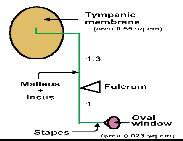
transfers all the power to the footplate of the stapes - like using a crobar/ |
|
|
Describe the Middle Ear Impedance Matching*** |
Air-to-fluid impedance mismatch= about 28dB Tympanic membrane (TM): 17x1 (concentrator) Ossicles Lever Action (LA): 1.3:1 (Fulcrum) TM ratio + Lever action (TM+LA)=30dB gain
|
|
|
Key concepts of Conductive HL |
Air conduction worse than bone conduction!!!! Word recognition is normal with elevated speech!!!! Abnormal immittance results Often corrected completely with medical treatment!!!! Maximum CHL 60dB with ossicular discontinuity with intact TM!!!!
|
|
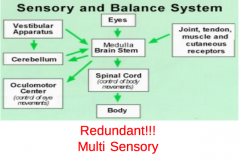
|
What are the sensory system redundancies? |
|
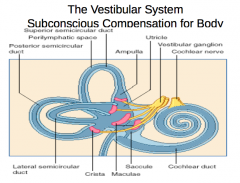
|
describe vestibular system |
|
|
What is vertigo? |
The sensation of movement in the absence of movement. The eyes are coin involuntary eye movement |
|
|
What is Labrynthitis? |
Inflammation of the vestibular system Nausea, vomiting subsides gradually over weeks.
|
|
|
What is Tramatic labrynthitis? |
often temporal bone fracture. nausa, vomiting resembles BPPV |
|
|
WHAT ARE THE DIFFERENCES BETWEEN A TEMPORAL BONE FRACTURE THAT IS LONGITUDINAL VE TRANSVERS |
Vertical can be ok transverse, if fluid drains, hearing is gone.CSF- cerebral spinal fluid
|
|
|
What is ENG/VNG? |
ENG/VNG Electronystagmography or videonystagmography, is the recording of nystagmus, a specific type of eye movement. |
|
|
what are the parts of the vestibular system? Three semicircular canals each side, Superior, Posterior, Horizontal Two macula each side Utricle, Saccule |
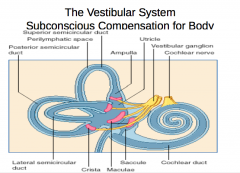
|
|
|
What is Nystagmus? |
is a condition of involuntary[1] eye movement, acquired in infancy or later in life, that may result inreduced or limited vision.[2] Due to the involuntary movement of the eye, it is often called "dancing eyes" |
|
|
How is the cochlea tonotopic? |
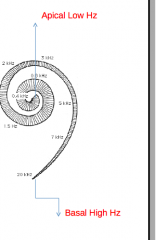
|
|

|
On each hair cell there is a steriorsilla connected to a nerve cell |
|
|
What is the difference between Type 1 afferent nerve cells and type 2 efferent |
30K type 1 afferent (myelinated) 1800 type 2 efferent (go to many hair cells) |
|
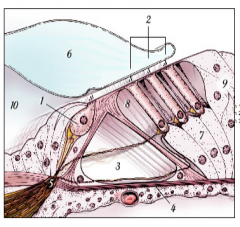
|
1-Inner hair cell (1 row, type 1 neuron, 3,000) 2-Outer hair cells Stereocilia, amplifiers, 3 rows, type 2 neuron, 12-15,000, imbedded in tectorial membrane) 3-Tunnel of Corti 4-Basilar membrane 5-VIII CN 6-Tectorial membrane (do not confuse it with Reissner's!) 7-dieter cells |
|
|
Describe outer hair cell innervation? |
WHen sound is softer a signal is sent to increase the signal and amplify a sound softer than 60dBs |
|
|
Describe inner hair cell innervation |
1. cochlear nuclei 2. lateral superior olive 3. medial superior olive floor of 4th ventricle Efferent innervation modulates signal to dampen loud signals. |
|
|
The tuning of the cochlea has to do with ... |
length and stiffness of hair cells |
|
|
What is the auditory pathway? |
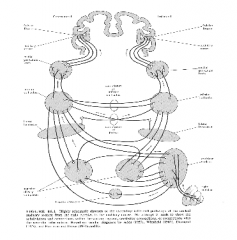
Cochlea Cochlear Nucleus Superior Olivary Nucleus Lateral lemniscus Inferior colliculus Medial geniculate body Auditory cortex |
|
|
meningitis cause hearing loss in how many cases? |
20% |
|
|
what are ototoxic drugs |
Those drugs known to cause permanent damage are the aminoglycoside antibiotics (gentamicin, and the cancer chemotherapeutic agents cisplatin and carboplatin. Those known to cause temporary damage are salycilates (aspirin), analgesics, quinine, and loop diuretics. |
|
|
what type of waves are there? |
longitudinal - all sound waves (compression and rarefaction) transverse- pebble in water |
|
|
what are properties of a wave |
wave length - one cycle Amplitude - how big is the wave
|
|
|
Frequency is measured in.... |
hertz |
|
|
Period is the duration |
period = .5 sec = 2 cycles per second |
|
|
What is the relation btw period and frequency |
period =1/hz shorter the period higher the frequency |
|
|
As lengthincreases as mass increases stiffness |
Hz decreases Hz decreases more elasticity vibrates at high f0 better |
|
|
harmonics create |
fullness |
|
|
what is interference |
cancelation or addition of waves noise canceling headphones |
|
|
what is fourier analysis |
decomposition of complex waves |
|
|
what is the speed of sound? |
1130 ft per sec at sea level |
|
|
what is a log used for |
to express a ratio btw 2 long #s |
|
|
what is a decibel? |
1/10 of a bel 10 bels in a decibel |
|
|
watts relates to... |
energy flowing through a 1cm2 surface |
|
|
a doubling of the sound pressure will ... a doubling of intensity will ..... |
....increase the loudness by 6db; 60dB + 60 db =66 ....increase by 3 |
|
|
Define: SPL: SOund Pressure level 1:1 to 2:1 add 6 IL: intensity level 1: to 2:1 add 3 HL: Hearing level 1000 Hz =7.5dB earphones and 0 insert earphones. SL: sensation level = louder than threshold |
SPL IL HL SL |
|
|
what is a phon |
a measure of energy to achieve same loudness. |

